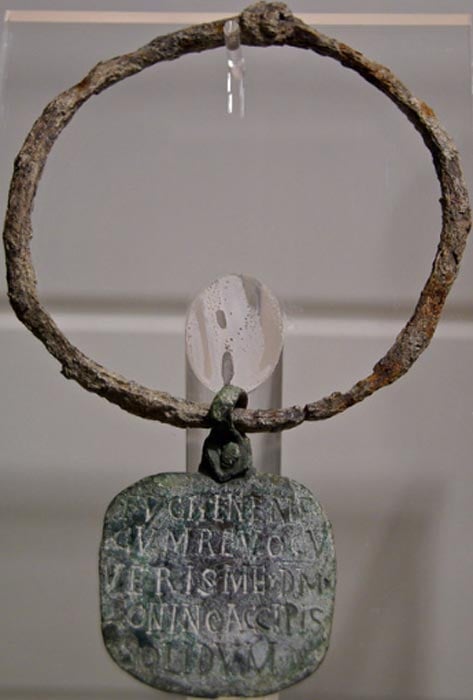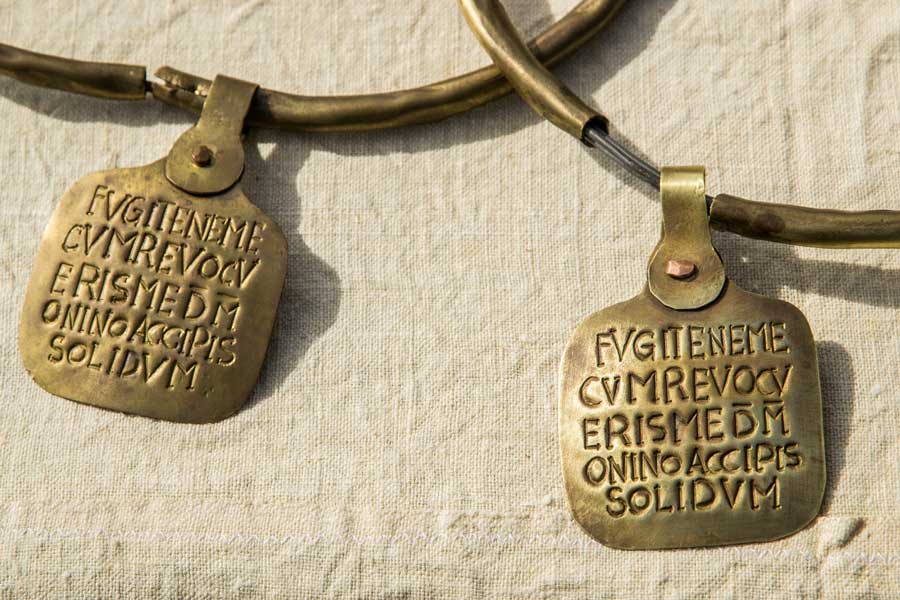“Hold Me Or I Will Run!” Roman Slave Collars Came With A Warning
Slavery was a large part of the Roman Empire. Military expansion brought captives, to compliment the material wealth taken back to Rome. And there is strong evidence that these slaves were not always treated kindly.
Around 45 examples have survived of “speaking” Roman slave collars. These tools of bondage were inscribed with warnings that the wearer was a slave, and reveal no end of information regarding their treatment.
One of the most celebrated surviving slave collar, famous for its completeness and preservation, is the Zoninus collar. A large latin inscription on the collar reads: “Fugi. Tene Me. Cum Revacaveris Me D. M. Zonino, Accipis Solidum.”
This translates to “I have run away. Catch me. If you return me to my master Zoninus, you will receive payment of one Solidus.” The payment of one Solidus in the 4th century AD amounts to one solid roman gold coin.

The Zoninus Collar (Sebastià Giralt / CC BY-NC-SA 2.0)
So, what can this tell us? This warning states to all who read it that the slave who bore this collar had run away and was likely to run away again. This indicates that slaves at least felt it possible that they could escape to freedom.
One Solidus was also a hefty price for the return of a slave, and an indication of their value for the Romans. And it speaks to the character of Roman society as well, where people would likely return property for a reward.
But what more can it tell us?
The Zoninus Collar
The Zoninus collar is considered the best-preserved collar in existence, the only known collar to still contain a tag from its iron wire neck ring. It also acts as the perfect example of urban slavery during the Christian 4th century Roman Empire. Every aspect of its creation reflected a significant clue to life in Roman slavery.
The collar was made from iron and bronze. As with many Roman collars, the neck size ranged from small to medium, for a snug and comfortable design. Its famous tag was hammered from a bronze sheet, and rounded in its corners so that it would not cut the slave who wore it.
- The legendary Spartacus: Gladiator and leader of slaves against the Romans – Part 1
- Roman Law and Its Lasting Influence On the Legal System of Europe
The collar’s simple iron wire neck ring was made to never be broken. Whoever was cursed to wear it was expected to carry it for life. Put simply the collar was heavy, straightforward, and brutal.
The Zoninus collar is unique however, because it is the only one that offers a reward for returning the runaway slave. Many scholars have also noted that the collar itself was considered a great punishment, since not all slaves were burdened with wearing one. This punishment seems to be limited to slaves who had escaped and were recaptured.

Slave wearing a collar (Shanker Pur / CC BY-SA 3.0)
Most of the collars carry inscriptions describing a disclaimer of disobedience and evasion. A common trait of the roman collars revealed inscriptions asking for the return of their slaves to their owners. The common phrase often inscribed reads “Revoca me” or “return me.”
Slaves In Ancient Rome
Those slaves on the run faced worse punishment than a collar if they were recaptured. Many Roman slaves were often tattooed on the face or forehead, indicating the extremity of their crimes to future slavers. By doing so, slavers hoped to demoralize the slaves, emphasizing they were considered as nothing more than property.
As is the case with the Zoninus collar, the slave master’s name was often included along with the disclaimer so that slaves could be returned to their rightful owner. In other collars, the address of the slave owner was also provided to assist in the runaway slave’s return. The common inclusion of such information suggests the slaves themselves were illiterate, not understanding the danger posed by the information around their neck.
Although the Zoninus collar was designed to be worn permanently, not all collars were so severe. According to writer Caroline Wazer, many different examples of collars have been found in the remains of roman trash heaps and Roman sewers all over the ancient world. While many slaves who carried the heavy collar were expected to adorn it for life, removable collars have also been found, maybe discarded by slaves who finally reached freedom.
The symbolic and physical weight of such imposing collars was a warning to all who would dare purchase such a rebellious slave, and to the slaves who wore them. It also acted as a symbol of their eternal bondage to the Roman Empire.

Slave ownership was an integral part of Roman domestic life, often appearing in villa decorations (Mary Harrsch / CC BY-NC-SA 2.0)
As with much of the history of slavery with Rome, the collar also brought awareness to how freed roman citizens viewed the people they shackled. Slaves in any given household could outnumber their Roman masters by three to one: a dangerous group who could, at any given opportunity, turn against their masters.
Rebellion against the Yoke
The Zoninus collar, as well as many others, is a stark reminder of the brutal and sorrowful reality of life in Rome. The city both feared and depended on its slave population for its survival, and would do anything it could to maintain its imprisoned labor population.
- Eunus: Slave ‘King’ and Leader of the First Servile War
- The Strict Rules Dividing Ancient Roman Social Classes
In Ancient Rome, it was estimated that one-third of the population existed as slaves. Slaves made up the manual labor force, working in commerce, trade, entertainment, artisan skills, brothels, and the fields. In the eyes of the Romans, an empire without slaves was not an empire at all.

Spartacus led the most famous slave revolt against the Romans (Hippopx / Public Domain)
Testament to the brutal grip the Romans exerted, there were only three famous widespread slave rebellions. The first servile war of Eunus in 135-132 BC, the second servile war of Salvius Tryphon in 104-100 BC, and the third Servile war of Spartacus in 73-71 BC.
All three lost against the Roman Empire. For most of Roman history, slavery continued and made sure its slaves remained pacified and working. However, the most common forms of slave rebellion came from individuals fleeing their masters.
The Fault Lies With The Master
As mentioned with the Zoninus collar and many others, running away was so routine that it was considered the fault of the slave owner. It was also the owner’s responsibility to include all relevant information regarding the nature of the slave on the collar. Roman law stated that the purchase could be void if the owner did not disclose any of this necessary information.
Running away became such a concern that entire businesses were dedicated to the recapture of fleeing slaves. It was very common for magicians to sell spells of invisibility to desperate slaves trying to leave. Slaves also used large lead tablets engraved with warnings, to protect them from being found.
Along with selling to desperate slaves, magicians also sold to the slave owners. Supernatural spells for slave recovery were common. But with all of the assurances in spells, slaves still fled, and masters still hunted them. In their perpetual game of cat and slave mouse, did the Roman Empire eventually soften in its punishment for fleeing in the hopes of reducing an escaping population?
Was The Collar Humane?
Although Roman collars reflected the harsh treatment of runaway slaves through their design, the collars may have been considered a humane alternative in dealing with rebellious slaves in the 4th Century AD. The other methods of punishing a slave for fleeing consisted of flogging, beating, and the branding or tattooing “fugitive” over the forehead or face of the captured slave.

There were advantages to leaving slaves unharmed. Here a slave girl is advertised for sale as a “21 year old virgin” (Oscar Pereira da Silva / Public Domain)
Although the collars were sometimes worn by a slave for life, in comparison to the methods presented, a permanent collar with inscribed warnings appeared to be a lesser sentence. Here, the slave remained physically intact and not mutilated in any way. And with such oppressive people like the Romans, the collar may have been the most humane way to treat the slaves they most depended on.
Top image: Replica Roman slave collars, after Zoninus. Source: nikhg / Adobe Stock.
By B.B. Wagner
References
Artifacts, Museum of. n.d. ROMAN SLAVE COLLAR. Available at: https://museum-of-artifacts.blogspot.com/2018/10/roman-slave-collar.html.
HAAS, INGRID DE. n.d. SLAVE RESISTANCE IN ANCIENT ROME. Available at: https://ultimatehistoryproject.com/slave-resistance-in-rome.html.
Pearse, Roger. 2016. “I have run away. Seize me!” – a slave collar of the time of Constantine, and other similar items. 26 March. Available at: https://www.roger-pearse.com/weblog/2016/03/26/i-have-run-away-seize-me-a-slave-collar-of-the-time-of-constantine-and-other-similar-items/.
n.d. Roman slave collar. Available at: https://imperiumromanum.pl/en/curiosities/roman-slave-collar/.
Wazer, Caroline. 2021. Slave Collars in Ancient Rome. 24 June. Available at: https://daily.jstor.org/slave-collars-in-ancient-rome/.




















Comments
Well, there were “slaves” with quite expensive “tags”…
I really love the text on this one,
ΛΕΓΟΥΣΙΝ
Α ΘΕΛΟΥΣΙΝ
ΛΕΓΕΤΩΣΑΝ
ΟΥ ΜΕΛΙ ΜΟΙ
ΣΥ ΦΙΛΙ ΜΕ
ΣΥΝΦΕΡΙ ΣΟΙ
https://www.livius.org/pictures/hungary/aquincum/aquincum-museum-pieces/...
Why on earth have you used a picture of a black woman wearing a thick collar, "Slave wearing a collar"? It does not match the content. The Roman collars did not look like that. Furthermore, while there may have been some black slaves, the majority of slaves were white, with the most prized slaves coming from eastern Europe.
--
Robertus